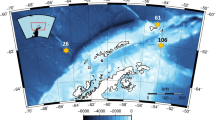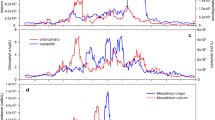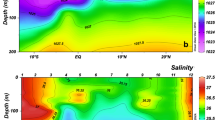Abstract
Top-down effects in the pelagic realm are quite well known in freshwater ecosystems. However, our knowledge of these effects in the ocean remains scant. It is known that copepods prefer to prey on ciliates and heterotrophic dinoflagellates, and their high or low abundances can change the structure of microplankton communities. Field studies in subtropical waters have shown parallel increases of mesozooplankton and phytoplankton without a lag, suggesting a top-down effect of mesozooplankton preying upon microzooplankton and releasing primary producers from predation. In the present work, we added copepods at increasing densities to natural plankton in 24 h experiments. A decrease in aloricated ciliates abundance of nearly 50% and increases in the abundances of picoeukaryotes, Synechococcus, Prochlorococcus, diatoms, and chlorophyll a were observed. No effect of nutrient additions was observed in parallel grazing experiments. Thus, a top-down effect of copepods upon microzooplankton explains the observed changes in the abundance of the different phytoplankton groups. Copepods promote important changes down the food web, structuring the community by predation upon microzooplankton. There are biogeochemical consequences of zooplankton variability over short time scales in the ocean.












Similar content being viewed by others
References
Allan JD, Richman S, Heinle DR, Huff R (1977) Grazing in juvenile stages of some estuarine calanoid copepods. Mar Biol 43:317–331
Andreae MO, Andreae TW, Meyerdierks D, Thiel C (2003) Marine sulfur cycling and the atmospheric aerosol over the springtime North Atlantic. Chemosphere 52:1321–1343
Beers JR, Stewart GL (1967) Micro-zooplankton in the euphotic zone at five locations across the California current. J Fish Res Board Can 24:2053–2068
Behrenfeld MJ, O’Malley RT, Siegel DA, McClain CR, Sarmiento JL, Feldman GC, Milligan AJ, Falkowski PG, Letelier RM, Boss ES (2006) Climate-driven trends in contemporary ocean productivity. Nature 444:752–755
Benoit-Bird KJ, Shroyer EL, McManus MA (2013) A critical scale in plankton aggregations across coastal ecosystems. Geophys Res Lett 40:1–7
Berggreen U, Hansen B, Kiørboe T (1988) Food size spectra ingestion and growth of the copepod Acartia tonsa during development: implications for determination of copepod production. Mar Biol 99:341–352
BjØrnsen PK, Kuparinen J (1991) Growth and herbivory by heterotrophic dinoflagellates in the Southern Ocean, studied by microcosm experiments. Mar Biol 109:397–405
Blackbourn DJ (1974) The feeding biology of tintinnid Protozoa and some other inshore microzooplankton. PhD dissertation, University of British Columbia
Bode A, Barquero S, Varela M, Braun JG, de Armas D (2001) Pelagic bacteria and phytoplankton in oceanic waters near the Canary Islands in summer. Mar Ecol Prog Ser 209:1–17
Borsheim KY, Bratbak G (1987) Cell volume to cell carbon conversion factors for a bacterivorous Monas sp. enriched from seawater. Mar Ecol Prog Ser 36:171–175
Broglio E, Jonasdottir SH, Calbet A, Jakobsen HH, Saiz E (2003) Effect of heterotrophic versus autotrophic food on feeding and reproduction of the calanoid copepod Acartia tonsa: relationship with prey fatty acid composition. Aquat Microb Ecol 31:267–278
Broglio E, Saiz E, Calbet A, Trepat I, Alcaraz M (2004) Trophic impact and prey selection by crustacean zooplankton on the microbial communities of an oligotrophic coastal area (NW Mediterranean). Aquat Microb Ecol 35:65–78
Burkill PH, Edwards ES, John AWG, Sleigh MA (1993) Microzooplankton and their herbivorous activity in the northeastern Atlantic Ocean. Deep Sea Res Part II 40:479–493
Calbet A, Landry MR (1999) Mesozooplankton influences on the microbial food web: direct and indirect trophic interactions in the oligotrophic open ocean. Limnol Oceanogr 44:1370–1380
Calbet A, Landry MR (2004) Phytoplankton growth, microzooplankton grazing, and carbon cycling in marine systems. Limnol Oceanogr 49:51–57
Calbet A, Saiz E (2005) The ciliate-copepod link in marine ecosystems. Aquat Microb Ecol 38:157–167
Campbell AS (1926) The cytology of Tintinnopsis nucula (FOL) Laackmann with an account of its neuromotor apparatus division and a new intranuclear parasite, vol 29. Publication Zoology, University of California, Berkeley, pp 179–236
Campbell AS (1927) Studies on the marine ciliate Favella (Jörgensen), with special regard to the neuromotor apparatus and its role in the formation of the lorica, vol 29. Publication Zoology, University of California, Berkeley, pp 429–452
Carpenter SR, Cole JJ, Hodgson JR (1985) Trophic cascades, nutrients, and lake productivity: whole-lake experiments. Ecol Monogr 71:163–186
Cullen JJ, Lewis MR, Davis CO, Barber RT (1992) Photosynthetic characteristics and estimated growth rates indicate grazing is the proximate control of primary production in the equatorial Pacific. J Geophys Res 97:639–654
Dam HG, Zhang X, Bulter M, Roman MR (1995) Mesozooplankton grazing and metabolism at the equator in the central Pacific: implications for carbon and nitrogen fluxes. Deep Sea Res Part II 42:735–756
DeMott W (1989) Optimal foraging theory as a predictor of chemically mediated food selection by suspension-feeding copepods. Limnol Oceanogr 34:140–154
Donaghay PL, Small LT (1979) Food selection capabilities of the estuarine copepod Acartia clausii. Mar Biol 52:137–146
Fessenden L, Cowles TJ (1994) Copepod predation on phagotrophic ciliates in Oregon coastal waters. Mar Ecol Prog Ser 107:103–111
Finenko ZZ, Piontkovski SA, Williams R, Mishonov AV (2003) Variability of phytoplankton and mesozooplankton biomass in the subtropical and tropical Atlantic Ocean. Mar Ecol Prog Ser 250:125–144
Frost BW (1972) Effect of size and concentration of food particles on the feeding behavior of the marine planktonic copepod Calanus pacificus. Limnol Oceanogr 17:805–815
Gold K (1968) Some observations on the biology of Tintinnopsis. J Protozool 15:193–194
Gold K (1969) Feeding experiments and lorica development. J Protozool 16:507–509
Gold K (1973) Methods for growing Tintinnida in continuous culture. Am Zool 13:203–208
Haas LW (1982) Improved epifluorescence microscopy for observing planktonic micro-organisms. Ann Inst Oceanogr Paris 58:261–266
Hansen PJ (1992) Particle size selection, feeding rates and growth dynamics of marine heterotrophic dinoflagellates, with special emphasis on Gyrodinium spirale. Mar Biol 114:327–334
Hernández-León S (1998) Annual cycle of epiplanktonic copepods in Canary Islands waters. Fish Oceanogr 7:252–257
Hernández-León S (2009) Top-down effects and carbon flux in the ocean: a hypothesis. J Mar Syst 78:576–581
Hernández-León S, Torres S (1997) The relationship between ammonia excretion and GDH activity in marine zooplankton. J Plankton Res 19:587–601
Hernández-León S, Franchy G, Moyano M, Menéndez I, Schmoker C, Putzeys S (2010) Carbon sequestration and zooplankton lunar cycles: could web e missing a major component of the biological pump? Limnol Oceanogr 55:2503–2512
Hollibaugh JT, Fuhrman JA, Azam F (1980) Radioactively labeling of natural assemblages of bacterioplankton for use in trophic studies. Limnol Oceanogr 25:172–181
Huntley MR (1982) Yellow water in La Jolla Bay, California, July 1980. II. Suppression of zooplankton grazing. J Exp Mar Biol Ecol 63:81–91
Ikeda T (1985) Metabolic rates of epipelagic marine zooplankton as a function of body mass and temperature. Mar Biol 85:1–11
Isari S, Antó M, Saiz E (2013) Copepod foraging on the basis of food nutritional quality: can copepods really choose? PLoS One 8(12):e84742. doi:10.1371/journal.pone.0084742
Isla JA, Llope M, Anadón R (2004) Size fractioned mesozooplankton biomass, metabolism and grazing along a 50°N–30°S transect of the Atlantic Ocean. J Plankton Res 26:1301–1313
Landry MR, Hassett R (1982) Estimating the grazing impact of marine micro-zooplankton. Mar Biol 67:283–288
Landry MR, Constantinou J, Kirshtein J (1995) Microzooplankton grazing in the central equatorial Pacific during February and August, 1992. Deep Sea Res Part II 42:657–671
Landry MR, Brown SL, Campbell L, Constantinou J, Liu H (1998) Spatial patterns in phytoplankton growth and microzooplankton grazing in the Arabian Sea during monsoon forcing. Deep Sea Res Part II 45:2353–2368
Libourel Houde S, Roman MR (1987) Effect of food quality on the functional ingestion response of the copepod Acartia tonsa. Mar Ecol Progr Ser 40:69–77
Löder MGJ, Meunier C, Wiltshire KH, Boersma M, Aberle N (2011) The role of ciliates, heterotrophic dinoflagellates and copepods in structuring spring plankton communities at Helgoland Roads, North Sea. Mar Biol 158:1551–1580
Longhurst AR (1991) Role of the marine biosphere in the global carbon cycle. Limnol Oceanogr 36:1507–1526
Malej A, Harris RP (1993) Inhibition of copepod grazing by diatom exudates: a factor in the development of mucus aggregates? Mar Ecol Prog Ser 96:33–42
Marcolin CR, Lopes RL, Jackson GA (2015) Estimating zooplankton vertical distribution from combined LOPC and ZooScan observations on the Brazilian Coast. Mar Biol 162:2171–2186
McManus MA, Alldredge AL, Barnard AH, Boss E, Case JF, Cowles TJ, Donaghay PL, Eisner LB, Gifford DJ, Greenlaw CF, Herren CM, Holliday DV, Johnson D, MacIntryre S, McGehee DM, Osborn TR, Perry MJ, Pieper RE, Rines JEB, Smith DC, Sullivan JM, Talbot MK, Twardowski MS, Weidemann A, Zaneveld JR (2003) Characteristics, distribution and persistence of thin layers over a 48 hour period. Mar Ecol Prog Ser 261:1–19
Menden-Deuer S, Lessard EJ (2000) Carbon to volume relationships for dinoflagellates, diatoms, and other protest plankton. Limnol Oceanogr 45:569–579
Meunier CL, Boersma M, Wiltshire KH, Malzahn AM (2016) Zooplankton eat what they need: copepod selective feeding and potential consequences for marine systems. Oikos 125:50–58
Nakamura Y, Yamakazi Y, Hiromi J (1992) Growth and grazing of a heterotrophic dinoflagellate, Gyrodinium dominans, feeding on a red-tide flagellate, Chattonella antiqua. Mar Ecol Prog Ser 82:275–279
Nakamura Y, Suzuki S, Hiromi J (1995) Growth and grazing of a naked heterotrophic dinoflagellate, Gyrodinium dominans. Aquat Microb Ecol 9:157–164
Nival P, Nival S (1976) Particle retention efficiencies of an herbivorous copepod, Acartia clause (adult and copepodite stages): effects of grazing. Limnol Oceangr 21:24–38
Pinheiro JC, Bates DM (2000) Mixed-effects models in S and S-PLUS. Statistics and computing. Springer, Berlin
Pinheiro J, Bates D, DebRoy S, Deepayan S, R Development Core Team (2011) Linear and nonlinear mixed effects models. R package version 3:1–102
Poulsen LK, Moldrup M, T Berge, Hansen PJ (2011) Feeding on copepod fecal pellets: a new trophic role of dinoflagellates as detritivores. Mar Ecol Prog Ser 441:65–78
Putt M, Stoecker DK (1989) An experimentally determined carbon: volume ratio for marine “oligotrichous” ciliates from estuarine and coastal waters. Limnol Oceanogr 34:1097–1103
Schmoker C, Arístegui J, Hernández-Léon S (2012) Planktonic biomass variability during a late winter bloom in the subtropical waters off the Canary Islands. ICES J Mar Sci 95:24–31
Sieburth JMCN, Smetacek V, Lenz J (1978) Pelagic ecosystem structure: heterotrophic compartments of the plankton and their relationship to plankton size fractions. Limnol Oceanogr 23:1256–1263
Simpson SJ, Raubenheimer D (2012) The nature if nutrition: a unifying framework from animal adaptation to human obesity. Princeton University Press, Princeton
Stibor H, Vadstein O, Diehl S, Gelzleichter A, Hansen T, Hantzche F, Katechakis A, Lippert B, Løseth K, Peters C, Roederer W, Sandow M, Sundt-Hansen L, Olsen Y (2004a) Copepods act as a switch between alternative trophic cascades in marine pelagic food webs. Ecol Lett 7:321–328
Stibor H, Vadstein O, Lippert B, Roederer W, Olsen Y (2004b) Calanoid copepods and nutrient enrichment determine population dynamics of the appendicularian Oikopleura dioica: a mesocosm experiment. Mar Ecol Prog Ser 270:209–215
Stoecker DK, Capuzzo JM (1990) Predation on protozoa: its importance to zooplankton. J Plankton Res 12:891–908
Strathmann RR (1967) Estimating the organic carbon content of phytoplankton from cell volume or plasma volume. Limnol Oceanogr 12(3):411–418
Strom SL (1991) Growth and grazing rates of the herbivorous dinoflagellate Gymnodinium sp. From the open subarctic Pacific Ocean. Mar Ecol Prog Ser 78:103–113
Suzuki MT (1999) Effect of protistan bacterivory on coastal bacterioplankton diversity. Aquat Microb Ecol 20:261–272
Ueda A, Kuwahara A, Tanaka M, Azeta M (1983) Underwater observations on copepod swarms in temperate and subtropical waters. Mar Ecol Prog Ser 11:165–171
Vadstein O, Stibor H, Lippert B, Løseth K, Roederer W, Sundt-Hansen L, Olsen Y (2004) Moderate increase in the biomass of omnivorous copepods may ease grazing control of planktonic algae. Mar Ecol Prog Ser 270:199–207
Verity PG, Langdon C (1984) Relationships between lorica volume, carbon, nitrogen and ATP content of tintinnids in Narragansett Bay. J Plankton Res 6:859–868
Verity PG, Robertson CY, Tronzo CR, Andrews MG, Nelson JR, Sieracki ME (1992) Relationships between cell volume and the carbon and nitrogen content of marine photosynthetic nanoplankton. Limnol Oceanogr 37:1434–1446
Wells ML, Vallis GK, Silver EA (1999) Tectonic processes in Papua New Guinea and past productivity in the eastern equatorial Pacific Ocean. Nature 398:601–604
Wickham SA (1995) Cyclops predation on ciliates: species-specific differences and functional responses. J Plankton Res 20:739–755
Yentsch CS, Menzel DW (1963) A method for the determination of phytoplankton chlorophyll and phaeophytin fluorescence. Deep-Sea Res 10:221–231
Zubkov MV, Sleigh MA, Tarran GA, Burkill PH, Leakey RJG (1998) Picoplankton community structure on an Atlantic transect from 50 degrees N to 50 degrees S. Deep Sea Res I 45:1339–1355
Zubkov MV, Sleigh MA, Burkill PH, Leakey RJG (2000) Picoplankton community structure on the Atlantic Meridional Transect a comparison between seasons. Prog Oceanogr 45:369–386
Zuur AF, Ieno EN, Walker NJ, Saveliev A, Smith G (2009) Mixed effects models and extensions in ecology with R. Springer Science & Business Media, Berlin
Acknowledgements
We wish to thank Sabrina Sánchez, Almudena Valenciano, Lidia Nieves, Valeria Anabalón, and Claire Schmoker for their help onboard. We also wish to thank David Morales for the time spent in carrying out the experimental work. This study was financially supported by projects Lucifer (CTM2008-03538), Malaspina (CSD2008-00077), Mafia (CTM2012-39587), and Bathypelagic (CTM2016-78853-R). Funding was provided by Ministerio de Economía y Competitividad.
Author information
Authors and Affiliations
Corresponding author
Ethics declarations
Conflict of interest
The authors declare that they have no conflict of interest.
Ethical approval
All applicable international, national, and/or institutional guidelines for the care and use of animals were followed.
Additional information
Responsible Editor: U. Sommer.
Reviewed by undisclosed experts.
Electronic supplementary material
Below is the link to the electronic supplementary material.
Rights and permissions
About this article
Cite this article
Armengol, L., Franchy, G., Ojeda, A. et al. Effects of copepods on natural microplankton communities: do they exert top-down control?. Mar Biol 164, 136 (2017). https://doi.org/10.1007/s00227-017-3165-2
Received:
Accepted:
Published:
DOI: https://doi.org/10.1007/s00227-017-3165-2




